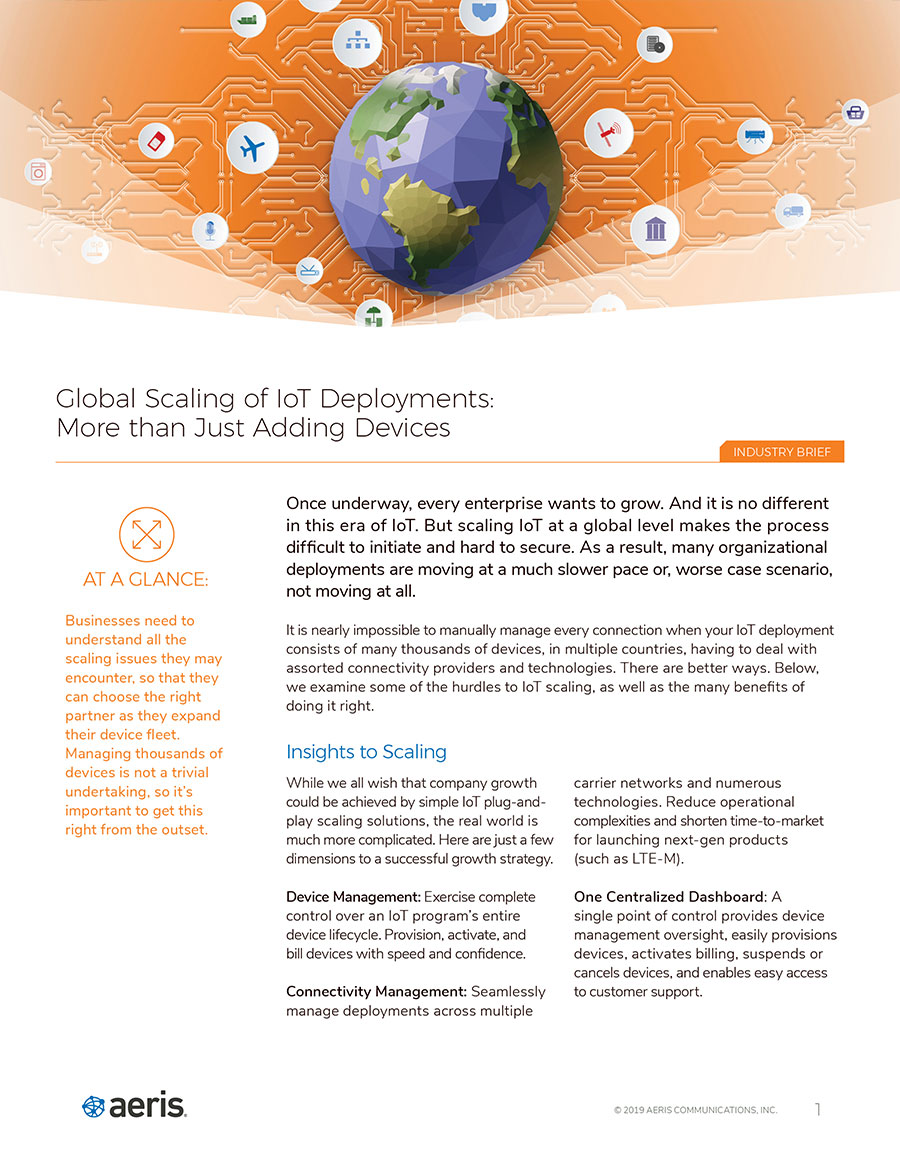
Businesses need to understand all the scaling issues they may encounter, so that they can choose the right partner as they expand their device fleet. Managing thousands of devices is not a trivial undertaking, so it’s important to get this right from the outset.
Once underway, every enterprise wants to grow. And it is no different in this era of IoT. But scaling IoT at a global level makes the process difficult to initiate and hard to secure. As a result, many organizational deployments are moving at a much slower pace or, worse case scenario, not moving at all.
It is nearly impossible to manually manage every connection when your IoT deployment consists of many thousands of devices, in multiple countries, having to deal with assorted connectivity providers and technologies. There are better ways. Below, we examine some of the hurdles to IoT scaling, as well as the many benefits of doing it right.
While we all wish that company growth could be achieved by simple IoT plug-and-play scaling solutions, the real world is much more complicated. Here are just a few dimensions to a successful growth strategy.
Device Management: Exercise complete control over an IoT program’s entire device lifecycle. Provision, activate, and bill devices with speed and confidence.
Connectivity Management: Seamlessly manage deployments across multiple carrier networks and numerous technologies. Reduce operational complexities and shorten time-to-market for launching next-gen products (such as LTE-M).
One Centralized Dashboard: A single point of control provides device management oversight, easily provisions devices, activates billing, suspends or cancels devices, and enables easy access to customer support.
Achieving Cloud Connectivity at Scale: Rather than overwhelming in-house servers, cloud accounts can lessen the load, especially if deployments are global in scale with country-specific cloud services.
Security Management: Security as an afterthought is a recipe for disaster. Multi-layered security at the design stage enables consistent, overarching safety to all your devices and data, regardless of how large the scaling endeavor proves to be. And planning for regional security and compliance requirements cannot start early enough as they will differ in each country.
Growing an IoT business means a whole lot more than just distributing and connecting devices. The processes you employ, and the functionality available to your expansion, can mean the difference between profit and loss, between success and failure. Here are a few of the must-haves for any scaling undertaking.
Zero Touch Provisioning (ZTP): A key piece of the massive IoT deployment initiative is the cloud. Cloud providers offer tools and platforms to help enterprises scale their IoT deployments. However, before an IoT device is available online, it needs to be on-boarded.
Cloud onboarding processes involve setting up each device to talk to the cloud by providing security context for IoT devices, device provisioning, and cloud provisioning, amongst many other steps. Trying to onboard millions of IoT devices to the cloud environment becomes a serious challenge in itself.
Zero touch provisioning is a solution that enables customers to securely provision / connect their devices to the cloud with minimum (near zero) effort. The Aeris ZTP solution addresses costly and time-consuming IoT provisioning processes, particularly with mass deployments of IoT devices. ZTP simplifies the process of on-boarding connected devices to the cloud, with limited need for customer action.
Over-the-Air (OTA) Updates: Over-the-air updates can be deployed to thousands of IoT devices at once rather than requiring each device in the field to be manually modified. OTA updates eliminate the need to send technicians into the field, save owners time and money, and make IoT deployments vastly more scalable. The ability to make changes to many devices remotely is important especially for operators of large-scale IoT deployments where updating devices manually would be a nearly impossible task.
Knowing which devices can receive updates at any given time creates the ability to deploy fast and update (security patches, product functionality, etc.) as needed, without sending personnel into the field.
Aeris Connectivity-Aware OTA enables up to 50% reduction in OTA failure rates and data costs; up to 50% reduction in time-to-completion for OTA campaigns; significantly reduces manual operations; and simplifies the complexities associated with global scaling.
Distribution Channel Package (DCP): Managing connectivity through distribution channels can be very difficult. The challenges are multi-fold and include large deployments with complex distribution channels, lack of visibility and control at the distributor level, and limited ability to influence end users.
The Aeris Distribution Channel Package enables OEMs to activate, test, and ensure correct device performance before sending devices to distributors. This helps simplify operational complexities of managing SIM assignments to distributor accounts.
DCP accommodates segment connectivity (wholesale / retail billing for lower tiers); delivers automated, fully customizable reports (for each account level); provides flexibility in managing end customer and / or accounts reseller tiers; and enables complete visibility and control of each tier―resulting in an optimized distribution channel, ease of scalability, and a reduction of operational costs for OEMs.
Risk Mitigation: How do you plan for meeting the challenges of data and device safety, conformity, compliance, and heightened security on a global basis, with an expanding attack surface each time you scale? The answer is to plan for all contingencies before deployment.
It starts by choosing the right cellular technologies and partners for various markets in different geographies across the globe, thereby reducing technology fragmentation that leads to reduced connectivity. It means leveraging emerging technologies to engage with distribution channels in a scalable manner. Risk mitigation enables the ability to quarantine and patch devices at scale. And it means having redundant capabilities, as in cloud services, as each country has rules and regulations regarding the movement of data across borders.
|
POWER |
SECURITY |
|
SENSORS |
PRIVACY |
|
CONNECTIVITY |
ANALYTICS |
|
SIZE |
FEATURES |
Aeris AerPort provides extensive device management capabilities tuned to the specific needs of IoT deployments. With AerPort, you can provision and suspend devices easily, adjust rate plans, start billing, add or remove static IP addresses, and conduct multiple functions across the deployment lifecycle. Aeris AerPort provides an overall reduction in operational complexity and cost while simplifying support processes.
Aeris also offers a rich set of REST APIs, which enable customers to effectively manage connectivity, including customer on-boarding, connectivity lifecycle management, network services, and deployment operations management.
As organizations look to IoT solutions for global growth, there are numerous considerations that often are overlooked. In many instances, companies lack the in-house expertise to address the myriad of issues that might arise. For instance, it’s impossible to manually manage every connection when your IoT deployment spans thousands of devices, multiple countries, and different mobile networks. As larger and larger IoT deployments gain traction, businesses need to re-think how to manage the growing scale of their devices.
All of this requires management oversight―to maintain connectivity, to facilitate the addition of new devices, to monitor status, to implement security protocols, and to ensure the smooth transmission of essential field and operational data. Businesses need to be sure that they can take care of the end-to-end communications lifecycle.
The Aeris Fusion IoT Network is a purpose-built, intelligent network with an industry-leading connectivity management platform that is designed to capture more data about IoT devices and their connections, providing unique capabilities you can’t find anywhere else. With the Fusion IoT Network, it’s one SIM for global connectivity.
The Aeris Fusion IoT Network makes it easy and cost-effective to grow from single region deployments to global implementations without the operational complexity of managing connectivity solutions. Additionally, this network adds the flexibility of carrier mobility through subscription management, multi-IMSI solutions, or by pairing the wireless subscription to the personal plan of end users.
Businesses should understand the issues they may face, so that they can choose the right partner to help them grow as they implement IoT plans and expand their device fleet. Managing thousands and thousands of devices is not a trivial undertaking, so it’s important to get this right from the outset. The Aeris Fusion IoT Network is committed to your success, regardless of where on this planet your business or IoT deployments live.



